Lawns in Manhattan? Homes with porches? That only happens, as a rule, in Marble Hill, the only section of Manhattan located on mainland USA — because of a massive engineering project that was finished nearly a century ago. Even though Marble Hill is politically affiliated with Manhattan, geographically and “spiritually” it’s Bronx all the way, as we’ll see.
Here’s an 1885 map of northern Manhattan and the Bronx, when the Harlem River flowed into the Hudson via the twisting, turning Spuyten Duyvil Creek, a notoriously difficult waterway to cross. On the Manhattan side, a lot of “paper streets” or streets planned but not yet built, are shown. The only route in northern Manhattan at the time was Kingsbridge Road, which was renamed Broadway sometime in the early 20th Century.
At the time there were two methods of passage across the waterway: Kings Bridge, to the north, and Fordham Bridge, where today’s West 225th Street and the Bronx’ West Kingsbridge Road are located.
Frederick Philipse built the first Kings Bridge, a tolled span over Spuyten Duyvil Creek, in 1693. Benjamin Palmer and Jacob Dyckman built Farmer’s Bridge in 1759 to avoid paying the high tolls charged by Philipse. During his retreat from the Battle of Harlem Heights in 1776, General George Washington and his company used both the King’s Bridge and Palmer and Dyckman’s free bridge to escape to White Plains.
By the late 19th Century, when the difficult conditions of the Hell Gate (where the Harlem and east Rivers meet) had been alleviated, and there was a need for ship traffic to be able to easily enter the Hudson, and thence the Erie Canal, Great Lakes and western United States. Therefore, Spuyten Duyvil Creek was straightened and dredged deeper to allow larger ships to use it.
After the newly christened Harlem River Ship Canal was completed, an island was left over between the canal and the remaining section of Spuyten Duyvil Creek. The section remained an island from 1895 to 1914, after which the old creek was landfilled, joining what was once the northern end of Manhattan to the mainland. This Interborough Rapid Transit map from 1908 shows the temporary island.
The name of Marble Hill was conceived by Darius C. Crosby in 1891 from the local deposits of dolomite marble, which is a relatively soft rock that overlay the Inwood and Marble Hill communities. The marble was quarried for the Federal buildings in lower Manhattan when New York was the Capital of the United States in the 1780s. Washington Heights and Inwood Online
Crosby (1832-1897) was a real-estate lawyer and community leader.
By the Roaring Twenties, Marble Hill had acquired its present appearance, with a street layout and beginning house construction. This 1949 Hagstrom is just about accurate today for Marble Hill with the exception of Leyden Street, which was absorbed into the property of Promenade Apartments.
The Marble Hill Metro North (formerly NY Central) station is shown east of Broadway, so that’s either an error or the station was later moved to its present location west of Broadway.
Entering Marble Hill
I took the IRT #1 train, which is undergoing a lot of repair work and was closed southbound (to get home I walked to the Jerome Avenue #4 train) at 225th Street, the northermost Manhattan stop on the #1 7th Avenue/Broadway line.
To see the Harlem River today it’s hard to believe it wasn’t in this position at all until the late 1890s. Looking south toward Kingsbridge Heights (left) and Inwood (right).
The el staircase is just north of Broadway Bridge, a mechanical lift span built in 1962, a product of complicated engineering that can elevate both the Broadway roadway and the elevated line high above the Harlem River to allow shipping through. In effect, it fulfills the same function the original Kings Bridge did when it was first built by Fredrick Philipse in 1693. The first Broadway Bridge, built to span the Ship Canal in 1895, is now the University Heights Bridge (spanning the Harlem between East 207th and Fordham Road) in modified form, after it was floated into position in 1908.
The Marble Hill Metero-North station is one in a series of stations serving both the commuter line and Amtrak trains on the eastern shores of the Hudson River. A high cliff separates it from the remainder of Marble Hill. Joint Amtrak and Metro-North service runs on the tracks just west of this station.
This Deco-area apartment building, with classic corner casement windows, is on West 225th Street (Henry Rivera Place) opposite the station. Rivera was a local Marble Hiller killed attempting to prevent a robbery in 1995. West 225th was formerly called Muscoota Street, a Native American term meaning “river along the geen sedge (marsh plants)” meaning the Harlem.
A pair of homes along Marble Hill Avenue. Many freestanding houses have peaks and cupolas, but nearly all have been homogenized by the addition of aluminum siding.
The shortest street in the neighborhood is Marble Hill Lane, a set of steps squeezed between apartment buildings from Marble Hill Avenue and West 228th. It resembles neighboring Inwood in its urbanity.
This illustration shows Phillipse’s Kings Bridge, built 1693, as it appeared in the colonial era.
Marble Hill Avenue north of West 228th. Kings Bridge, or one of its successors, is still located under the street surface, as it was not removed when the original creek was landfilled here in 1914. The name of the street changes midblock to Kingsbridge Avenue at the Bronx-Manhattan borough line.
The oldest building remaining in Marble Hill is likely St. Stephen’s Methodist Episcopal Church, which as the cornerstone says, was built in 1897 (Alexander McMillan Welch). The congregation dates to 1826 in what would be the Mosholu Parkway area, moving to Riverdale in 1876.
[T]he historic Shingle-style building features a tall bell tower at the corner and tall gables terminating in broad pediments that frame circular stained glass windows on both street facades. The interior is based on the “Akron Plan,” a popular style of Protestant church architecture in the nineteenth-century that provided increased capacity and encouraged participation when adjacent Sunday school classrooms were opened into the auditorium. At St. Stephen’s, the Sunday school classrooms on the second floor balcony are divided by rolling partitions that can open into the amphitheatre-style auditorium below. Above the curved oak pews is an extraordinary wood ceiling paneled in a herringbone design. American Guild of Organists
The longtime pastor (1946-1977) of St. Stephen’s, Dr. William A. Tieck, was also a Bronx historian and founder of the Kingsbridge Historical Society. He wrote several historical books about the Bronx, including Riverdale, Kingsbridge Spuyten Duyvil New York City, A Historical Epitome of the Northwest Bronx. He preceded Lloyd Ultan as the official Bronx County Historian.
A freestanding peaked beauty at the corner of Adrian Avenue and West 228th. Many Marble Hill streets were named for Dutch settlers in the colonial era; Adriaen Van Der Donck, New Amsterdam’s first lawyer, was granted permision to buy land from Native American tribes in 1646. The tract included hundreds of acres along the Hudson from Spuyten Duyvil to Yonkers, the city Van Der Donck is credited with founding. His nickname, Jonckheer (“young squire”), was bowdlerized by the British who took over later as “Yonkers.”
Van Corlear Place may be the most untypical street in Manhattan, as it curves gently twice and features freestanding homes as well as a couple of attached brick buildings.
Van Corlear was the official messenger sent by Governor-General Peter Stuyvesant to get reinforcements from the mainland when Nieuw Amsterdam was attacked by the British Fleet. According to legend and mentioned in Father Knickerbocker’s History of New York by Washington Irving, van Corlear was drowned when he crossed the creek and was pulled down by a giant mossbunker. In reality he waded across the Spuyten Duyvil Creek. Washington Heights and Inwood Online
Occasional guides show this as Corlear Place, but the street signs included the Van.
Van Corlear and Jacobus Places come together at a slight rise. Catercorner are a large brick apartment house and a pair of eclectic private houses. The “Jacobus” is Jacobus Dyckman, who ran the Dyckman Tavern in the area in the late 1790s and assisted in sponsoring the Farmers Bridge, the free route across the Harlem River. Other sources have it as honoring Jacobus Van Cortlandt, a two-time NYC mayor (1710-11, 1719-20). Or, perhaps, it was David Schenk Jacobus, a professor of engineering at Stevens Tech across the river in New Jersey in the 1860s.
The Promenade Apartments dominate the west end of West 225th Stret. The bedrock is deep in this part of town and high rise apartment buildings dot southern Spuyten Duyvil.
The corner of West 225th and Adrian Avenue is decidedly Bronx-like, as gently curved corner buildings like this are scattered all over the borough.
Teunissen Place, a dead end off Terrace View Avenue, is named for the first settler in what became Marble Hill; Tobias Teunissen, a wool washer and farm hand who had previously been a night watchman in Leyden, Holland, in the 1630s. He was killed in 1655 by the Weekwaeskeek Indians in a raid, though his wife and 4 children were later ransomed from the tribe.
104 Terrace View Avenue, an early apartment building with stained glass and terra cotta ornamentation, overlooks a valley into Spuyten Duyvil.
John F. Kennedy High School, 99 Terrace View Avenue, opened in 1972 (hence the bland architecture) was once called one of the most dangerous high schools in the city, but conditions have improved since a student was murdered on campus. Sports teams are nicknamed the Knights of the Red Flaming Torch. In his youth, President Kennedy resided for a couple of years with his family in Riverdale, a couple of miles to the north.
Freestanding, porched homes with lawns, Terrace View Avenue, Manhattan.
This house was undoubtedly altered greatly from when it was built, with a ground floor garage, enclosed porch and siding. Terrace View Avenue near curve to West 228th Street.
West 228th near Adrian. Just as Marble Hill resembles the Bronx more than Manhattan, it’s subject to creeping Fedderzation, unlike the island portion of New York County.
This contrast can be found frequently in the Bronx, the Borough of Apartment Houses, adjoining two-family homes from earlier in the 20th Century.
We have crossed the borough line into the Bronx. This boxy building at Kingsbridge Avenue and West 230th labeled Telephone Building is one of several scattered around town, always plain jane brick buildings with quoins and window lintels, but otherwise no nonsense architecture.
Just as Marble Hill was temporarily an island, so West 230th was at the southern end of a former island, Hummock Island, occupied by colonial settler Alexander Macomb. The island was eliminated by landfill after 1916. At the west end of the street, the city’s longest step street extends 4 blocks from Riverdale to Netherland Avenue.
The Roman Catholic St. John’s parish was established in 1877; the handsome Tudor-style church building with its distinctive zig zag patterned spire was built from 1904-1910.
Next door to St. John’s, at Kingsbridge and West 231st, is the Bronx Mediator Church, established in Yonkers in 1855, with the present brick building completed in 1914 by architect Henry Vaughn, who also designed the National Cathedral in Washington, DC (which took over 80 years to complete). The church features Tiffany windows in its chapel.
The West 231st Street station at Broadway has recently seen its Swiss chalet-style station house repaired and repainted, though ongoing work was still being done in September 2011.
Couldn’t exit this part of town without paying tribute to this classic 1915-era Bishop Crook Type 24a, Broadway near West 230th.
10/29/11


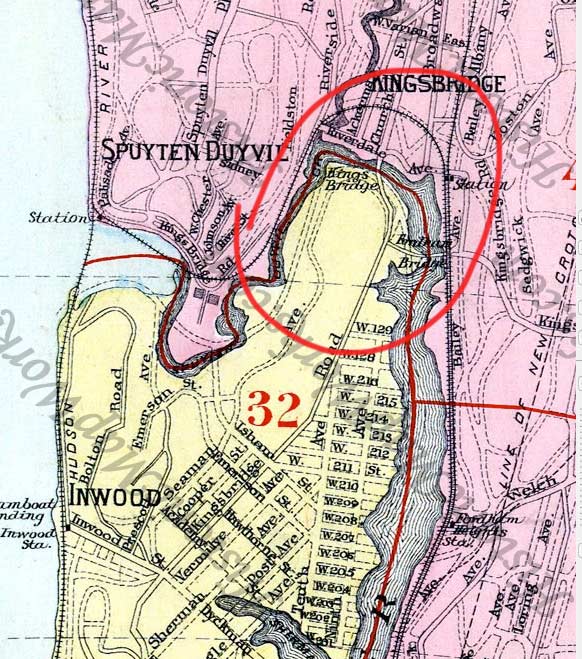




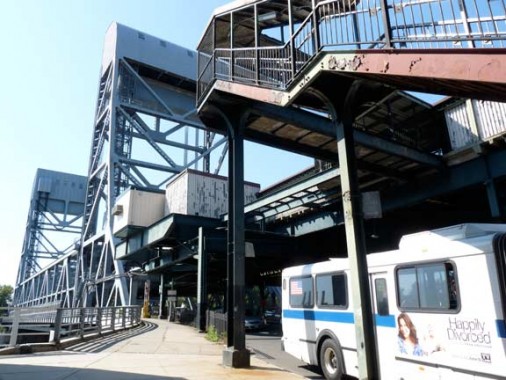
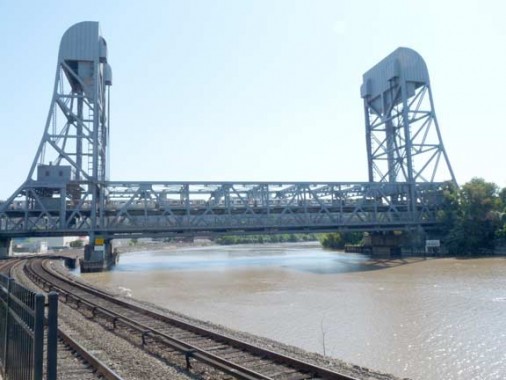
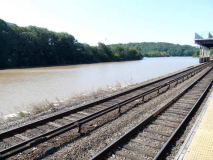
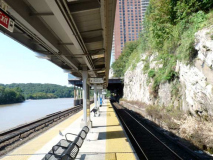

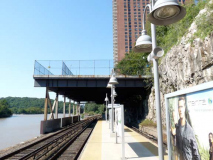
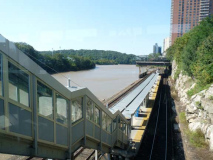
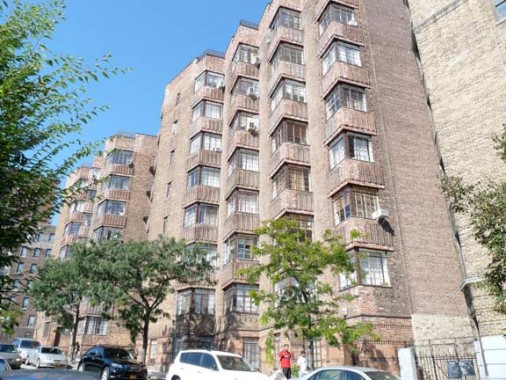

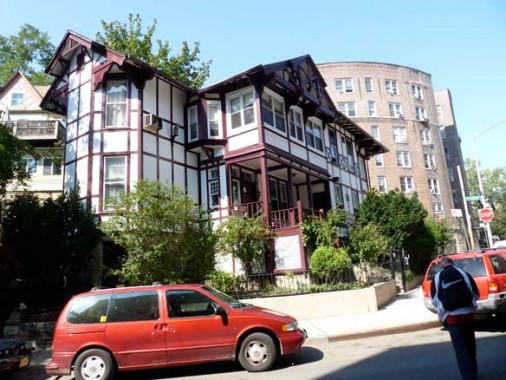






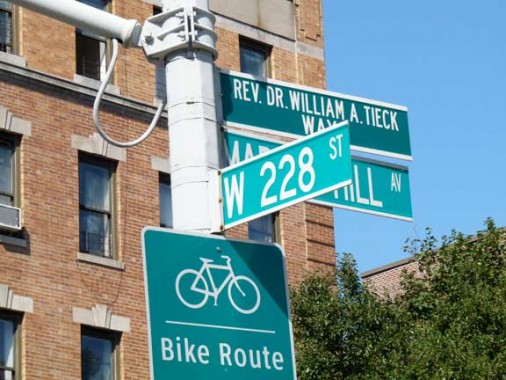
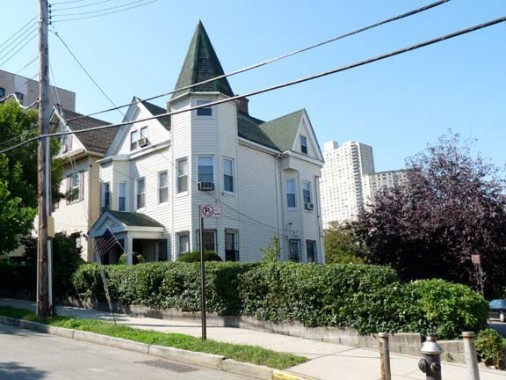
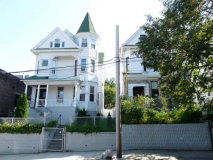
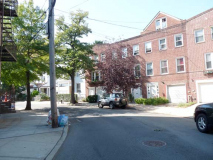
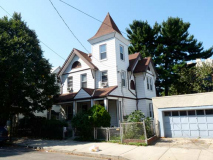
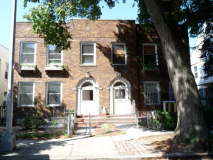
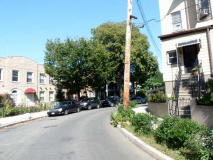
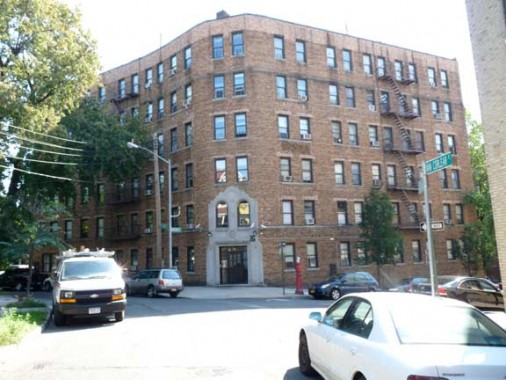



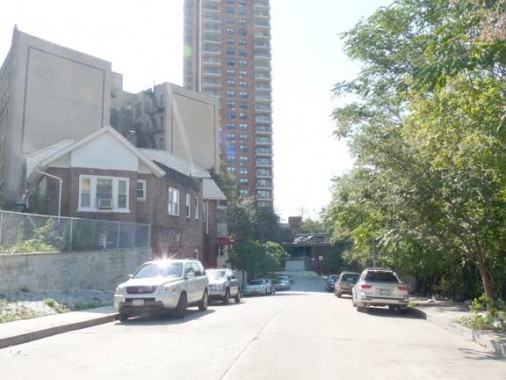
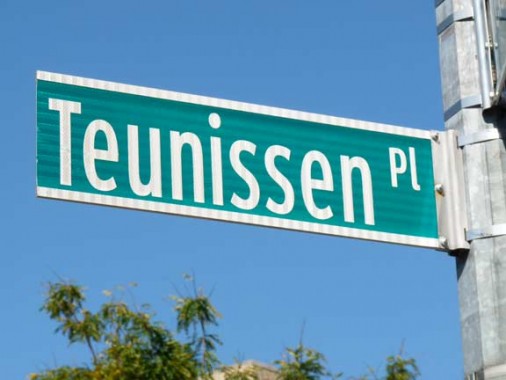

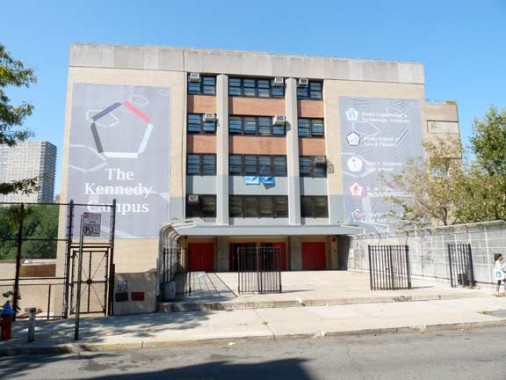


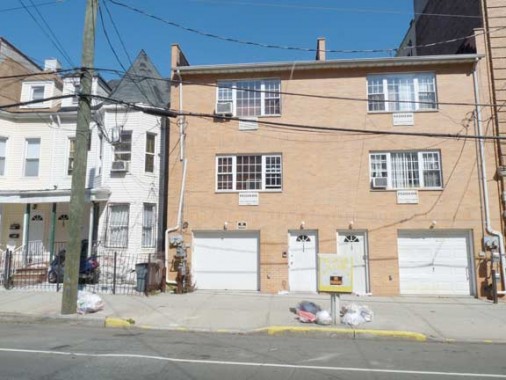
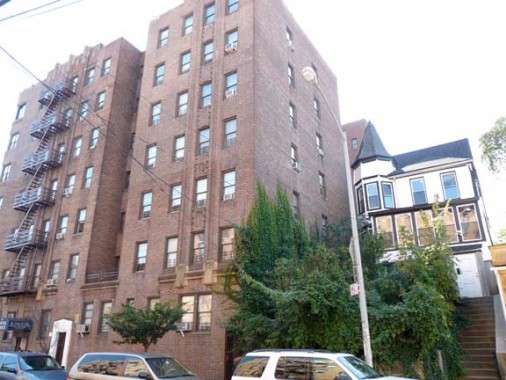


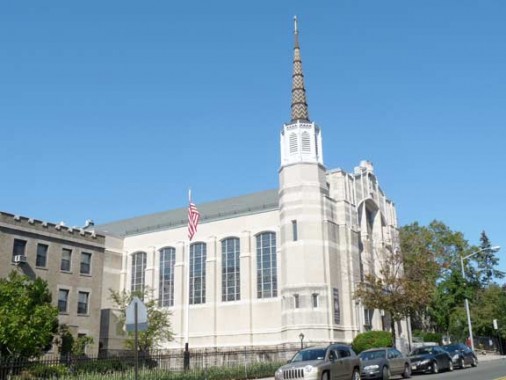

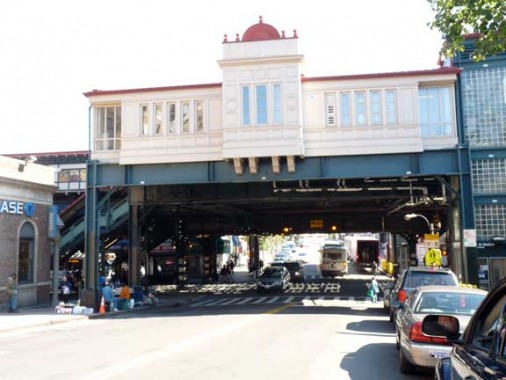

92 comments
Fascinating and diverse neighbourhood. Those old houses are gorgeous, especially the ones on Marble Hill Avenue and the “freestanding peaked beauty”. And it’s always great to see some lesser-known New York City Art Deco.
Manhattan? After all these years, that was news to me.
I always thought that when I stood at the Marble Hill Train Stop, that I was actually standing in the Bronx!
Another great ‘tour’.
Two brief points.
1) Nobody I knew called what you call ‘The Broadway Bridge’ anything but the 225th Street Bridge.
I came from up hill at Kingbridge Rd & University Ave, but Marble was part of our Baily-wick.
2) Just seems a little odd to have a segment on Marble Hill and not show or even reference the Marble Hill Projects.
Tnx,
‘tic
Now that’s a big “WORD”.
Great website. I always enjoy any articles about Marble Hill, as many people do not know the history, and think it is simply “The Bronx”, or do not understand why it is “part of Manhattan”.
Just some information regarding the railroads….
Regarding The Metro-North station, yes, it was formerly located to the east of the bridge under New York Central times. The railroad layout has changed dramatically over the past century at Marble Hill to the current state.
Amtrak parts ways with The Hudson Line at Spuyten Duyvil onto it’s own “Empire Line”, formerly The New York Central West Side Line into Manhattan. The only time Amtrak goes east of Spuyten Duyvil, and into Marble Hill is if there is a problem with the bridge at Spuyten Duyvil itself. (Detours).
Besides that, again, great site, keep it up!
Michael Foley
I grew up on Godwin Terrace (between 230th and 231st Streets) across from the then St. John’s grammar school. I remember before the projects were built when the land where Targets and JFK school now stand was farmland. Where JFK is now located there was a shanty town. In the summers (before the projects were built) breezes would blow off from the Harlem River and cool the neighborhood. There were plenty of empty lots for children to play in at 230th Street and Riverdale beyond had no sky scrapers. Once you hit 207th Street there were little or no commuters on the subway line. The grammar school on Godwin Terrace had no upper floors so you could see clear to Van Cortlandt Park from the 4th floor apartment windows located across from the school. At that time, we considered anything south of 230th Street Manhattan. And still do.
Hi,
I grew up in the Marble Hill projects in the 70’s and 80’s. I always considered myself a Bronxite. So far as I was taught, Manhattan started when one crossed the Broadway Bridge going south. My zip code was Bronx 10463, and my school district was Bronx as well.
I grew up in the projects in the 50s and 60s. We voted in Manhattan (the voting place was in the project but it was a Manhattan district) so we thought of ourselves as Manhattanites. My building, 5480 Broadway had its front door in Manhattan (which was why we voted in Manhattan) but the apartment we lived in was in the Bronx, as the dividing line went through the building.
Wow!
Ilived at 5480 Broadway too. Apt. 3B Maybe we were neighbors?
I grew there as well, building 6. Right in front of the Dairy. .50 milk qt, .50 cent half gallon juice (fruit punch, Grape, Orange, Pina colada). Exterior St. Fam still lives there. Graduated JFK.
Me too. Please contact me. I am trying to locate residents from this building.
Before the zip codes were expanded, the Post Office had NY 63 stenciled on their window. Unique to postal zones, . zone 63 was the only zone that included two boroughs (Bx.. and Mahattan). Also juristictional policing conflict between the 34th and 50th Pcts. Catholic residents of Marble Hill were part of St. Johns parish although arguably in Good Shepards parish residents.
I remember most of what you say. Grew up on Godwin Terr. during 40s and 50s
The Marble Hill train station was indeed relocated from the east side of Broadway. I think it was in the 1980s, but I’m not certain of that. And Amtrak trains do not run there, and haven’t since the early 1990s, when “Empire Corridor” trains were routed into Penn Station.
I stated that Amtrak trains join the line west of the station.
Awesome Kevin. It’s been a few years since I’ve had the pleasure of walking around Marble Hill, and your pics and text took me right back! I often wished upper Manhattan (say from the GWB north) was developed with single family homes instead of apt buildings. How beautiful those peaks and valleys would have been if they had homes similar to Marble Hill Ave. Curious to know how much one of those homes goes for nowadays…
I am curious if Marble Hill residents think they are either Manhattan or The Bronx. Despite being considered part of Manhattan, Marble Hill tends feel like The Bronx, and that picture will probably be the only Fedders Manhattan will ever have. Then again, much of upper Manhattan tends to resemble what the outer boroughs are like. Let’s not forget that Harlem has its own website as if it was never part of the city as there is also another one for Inwood and Washington Heights. BTW, that Metro North station did have its platform recently expanded. Still, it’s always nice to see a part of the city that most guidebooks never seem to touch, which is good at times because it gives us a more local look rather than just being dominated by chains and corporations to make it look so touristy.
I lived there from 1951 to 1968 and were listed in both Manhattan and Bronx phone books. Alway considered ourselves as living in “The Bronx”.
If you grew up on Marble Hill, you were indeed actually living in Manhattan. For most of us though it was rather impratical because we were separated from the rest of Manhattan by a bridge, which in your youth seemed like you were crossing to another world. We always had the mentality that we were the ‘last” neighborhood in Bronx, as opposed to the first neighborhood in Manhattan. Because we were connected by land to the rest of the Bronx, it just seemed most practical to do our shopping, socializing and schooling within Kingsbridge. I guess a small body of water, was a vast divide from the rest of Manhattan.
The people who live in apartment buildings, for the most part, don’t even know they live in New York County. The people who live in the private homes would know because they pay property taxes to NY County. The more open debate is – do the residents live in Manhattan? If Manhattan is only an island, then they don’t. But they politically live in NY County. I grew up in a private home in Marble Hill and we never really thought about it until they took away our 212 area code (we were the last to lose it). It was, however, definitely a Bronx experience growing up in the neighborhood. Thank you for the lengthy and well researched piece!
I love all these little “mini tours” you take me on everyday. As an office worker, I never get to go scouting around to see all of our area as much as I would like to, and because of you, I get to enjoy these little trips all the time.
Marble Hill is pretty, I would love to ride my bike around there, hopefully next summer….but in the meantime, thank you for the great tour!!
Great tour, Kevin.
That altered white monstrosity on Terrace View Avenue affects not only the look of the block, but the selfish way that van driver parks forces everyone to step into the street.
I grew up in the house to the right of to the monstrosity. They did not look like that then, the porches have been enclosed and added onto ( above and below) extending the houses out towards the street. Our address was Terrace View Ave, Bronx NY. Not NY New York.
HELLO KEVIN.
EXCELLENT TOUR OF THE MARBLE HILL SECTION OF “THE BRONX” LOL!! I WAS FACINATED AT THE EXTREME BEAUTY OF MY NEIGHBORHOOD AND THE RICH HISTORY. I WAS ALSO TROUBLED HOW YOU COULD PRESENT ALL THIS HISTORY AND A GREAT WEBSITE AND NOT INCLUDE MARBLE HILL HOUSES, THE PROJECTS THAT RUN FROM 225TH AND BROADWAY TO 230TH ST, FROM BROADWAY TO EXTERIOR ST. YOU INCLUDE THE HISTORY OF THIS ENTIRE AREA I JUST MENTIONED AND FAIL TO SHOW 1 PICTURE OF MARBLE HILL PROJECTS OR EXPLAIN ANY HISTORY ABOUT ITS CONSTRUCTION! YOU EVEN MENTION THE PROMENADE AND SHOW PICTURES, AND KENNEDY HIGH SCHOOL BOTH OF WHICH WERE BUILT YEARS AFTER MARBLE HILL PROJECTS!! US MARBLE HILLIANS IDENTIFY OURSELVES AS “BRONX NATIVES”!! AND WE WOULD APPRECIATE IT IF YOU WOULD INCLUDE SOME HISTORY AND PICTURES OF MARBLE HILL HOUSES ON YOUR WEBSITE!! THANK YOU.
IVAN
I don’t think they were on the Manhattan side where the river originally ran.
The smaller collection of Marble Hill Houses that are bordered by Broadway – West 228th Street – Marble Hill Avenue & West 230th Street were part of Marble Hill before the ship canal project. The larger collection of the housing project have always been geographically and politically part of the Bronx.
I thought the canal ran through 228th St
Part is in the Bronx and the other part is in Manhattan. I recently retired from the Housing Authority. For legal reasons the project is divided as ugh.
you did a great job capturing the essence of the neighborhood. As I look at this pictures I could see myself as a 10 year old living there.
Before the Harlem River Ship Canal was finished in 1895, the New York Central ( right of way ) traveling south came through the Cut and turned left ( north ) and followed the outline of the Spuyten Duyvil Creek. The New York Central ( right of way ) continued up to West 231st St. and followed east and then south. Around 1905 the New York Central ( right of way ) detoured to its present course following the Harlem River Ship Canal. Also, Tibbets Creek followed the present day Tibbets Ave. from the Waterfalls at Van Cortland Park and met up with the Spuyten Duyvil Creek at West 231st St and Riverdale Ave. The Tibbets Creek was filled in during the 1920’s. The History and Photo’s of the area are all in Rev Dr. William A. Tieck’s Book. There is a copy of the book at the Kingsbridge Library on West 231 st St.
Regarding the location of the Marble Hill Metro North station on the 1949 Hagstrom map, that location is correct for 1949. The original location of the station was on the east side of the broadway bridge, and had grade-level platforms (see the 1960 photograph located at http://www.nycsubway.org/perl/show?41820). It was most likely moved to its current location after the formation of Conrail in 1970 and before the formation of the Metro North Railroad in 1983.
For the record, most Marble Hill residents do not consider themselves Bronxites, but Manhattanites. Because we are Manhattanites.
What zip code is Marble Hill? 10034? 10463? What area code are the land lines?
When I lived there, it was 10463. Adrian Ave.
[…] barely scratch the surface. If you would like to know more I’d recommend the Marble Hill page on the Forgotten New York site. Great site, by the way. You’d do well to bookmark […]
Kevin, just a little fyi, the Marble Hill Lane sign looks to be not only urban, but an active drug spot. A lot of corners in brooklyn have brown or white shoes around signs or telephone wires meaning that the spot is or was an active drug corner. White means coke, brown is smack, and usually bob marley shirts meant weed…
I moved there in 1999 and I’m about to buy one of the houses. We used to be the only ones in the Bronx to be represented by Charlie Rangel, but the district has been gerrymandered and he may be replaced by the first Dominican-American in Congress. Also, the Bronx County courts send us jury duty notices, but after much confusion it’s usually realized that we’re supposed to serve in Manhattan courts, which I’ve done twice since living here. But being in school district 10 rather than district 6 is yet another way that MH is the Bronx rather than Manhattan. Also, when my son was young we tried to see if we could get him into Hunter Elementary School, but they wouldn’t even send us the application for the test because we were in a Bronx zip code (10463), despite our insistence that we pay taxes in New York County, etc.
That’s odd.
I grew up in the Marble Hill projects and i went to Hunter 1979-85. The test was open to anyone in the five boroughs.
Hunter High School is open to all 5 boroughs, but not the elementary school. You have to be a Manhattan resident for that. I attended ’95-’01 from Queens.
Fun fact about that jury issue, I’ve heard (third party, so forgive any inaccuracy), that Marble Hill residents whom are called to Bronx courts cannot serve, and if they somehow fall through the cracks and do serve, it’s actually grounds for a mistrial!
Kevin,
Great job! As to whether or not Marble Hill is a part of Manhattan, that was never in question to the residents other than trivia. The tel. exchange told you that; LO 2- 1234 (Lorraine 2) was and still is a Manhattan exchange. “Back in the day,” as they say, when someone was asked where they came from the usual reply was what parish they belonged to. In the case of Marble Hillers and the Kingsbridgeites south of 238th Street the reply would have been the same,St. John’s. Sadly, that little bit of New York provincialism has gone the way of trolleys, Belgian block streets and “Parkies.”
My phone number was Lorraine 2 – 6932.
Henry Rivera was killed in 1992 not 1995.
This is true. how do you know that? did you know henry?
Hey Max! Yes I knew your dad since I was about 10yrs old. Miss him a lot still.
I’m the one who introduced Henry to your mom. Chrisannnyc@aol.com
I grew up in 70 marble hill 5 floor walk up and never thought about it ,the 5 floors I mean .No cell phones making hot rods out of baby carrage wheels,2x4s and what ever else you could find ,curb ball,for moons ,the sugar house ,Adrian Ave,hitching freights ,Swimming at the ” Cut ” .What a great place to grow up a book could be written of all the experiences good and bad .
I lived at #70 also, during the 1970s. Happy memories.
I lived at 108 W 227 St from 1940 – 1961, and remembered the “sugar house” at the north end of 70 Marble Hill Ave. Also remember Francis Conlon, the Schoenfelds, Dodges, McNamaras, Quasts, Salmons, Stiles’, Harold Sartain, Robert Nenninger, Bill Hayward, to recall a few. Was the caretaker at St Stephens Church named Ebeneezer?
I’m responding more than a year later (just reminiscing about Marble Hill) and I do remember the Stiles farmily_- but the ones I knew lived on “my street” — Van Corlear Place — Emerson Stiles and his sister Virginia….then we later moved to 95 Marble Hill Avenue. My sister and I attended St. John’s School and Emerson was in my class… amazing to recall all this!! I also remember Ebeneezer — I remember he was “old” and had a humpback… Thanks for resurrectling these memories…
I was friendly with I think Dick Stiles and also Richard Salmon (58 MH Ave). The Stiles had a wire recorder and Dick and I used to record skits with his father playing piano. Also the tudor house at the corner of MH Ave and Ft Charles Pl was bought by the Dodge family (warren, bobby) but in the early 40’s it was vacant and we kids played in it, much to my mom’s dismay. BTW I was born at 108 W 227th in 1940.
Great job…I enjoyed revisiting places of my youth.I grew up in marble hill, in the cute little house at 44 van corlear place.I loved taking the tour
Hi Donna/Mike. Was searching Marble Hill/Adrian Ave. and came across your comment. Trust you and family are well. Don’t know if you will ever read my comment,seven years after your 2013 message
but I thought I would give it a shot. Give us a message at driordan4@optonline.net.
Janet/Dennis Riordan
Reference is made to your caption:
“The Marble Hill Metro North (formerly NY Central) station is shown east of Broadway, so that’s either an error or the station was later moved to its present location west of Broadway.”
The latter supposition is true. Having grown up in the area in the 60’s and 70’s I can testify that the former station was a wooden affair at (near) ground level. The old New York Central trains could pick up and drop off passengers at either ground level or platform level. There were steps on the railway cars to accommodate the former and a steel plate which could be placed over the steps at car floor level to serve passengers at platform level. My dad had an office at 42nd Street & 2nd Avenue and would take the train to and fro almost daily.
I was seeking this particular info for a long time. Thank you and good luck.
My children are the 5th generation fr my family to grow up on Marble Hill. It was a wonderful place to grow up. These pictures have brought back many memories
R
When the Marble Hill Houses were being built after the post-WWII era, it was done over two demapped short, dead end side streets off the eastern side of Broadway: West 226th Street [formerly Hyatt Street] and West 227th Street [formerly Ashley Street]. This information supplements the Hagstrom map posted as it was found also through the Historical Map Works.com website with a 1925 Land Block Map, plus a 2001 Sanborn map issued for the city’s DOT.
I lived at 108 W. 227 St from 1940 until 1961, and always considered it to be Manhattan. A few notes on “A pair of homes along Marble Hill Avenue”. The house in the foreground was deserted when I was young, we called it the haunted house and we used to play in it until my parents were afraid I’d get hurt. It was bought in the 40’s by the Dodge family (a son Warren and some others) and was painted yellow. 108 W 227 St is the apartment building in the background, built in the late 30’s – 6 stories, art deco foyer and an elevator (required for 5+ stories). Our group of friends lived mainly at 58 and 70 Marble Hill Ave. I went to PS7 on Kingsbridge Ave and 232 St, and had many friends that went to St Johns on Godwin Terrace.
Great Article!!
My Mother grew up in the Freestanding Peaked Beauty. They left there in the later 1950s to move out to Long Island, but my Mother speaks fondly of wandering the streets as a young girl.
KEVIN – GOOD JOB!
Thanks for producing a comprehensive, illustrated slice of history, detailing and documenting what so many have simply “wondered about.” Thanks for showing the location of the creek, where the amputation of Manhattan was, and explaining so clearly why it is all so confusing!
Also, I didn’t know the 207th Bridge was once the Broadway Bridge, and was floated down in 1907. I thought it was constructed at its present location in 1907.
I’d like to add – although Marble Hill is “in Manhattan” – but not on it – it isn’t the sole exception. The Borough of Manhattan (New York County) also includes Roosevelt Island, Wards and Randall’s Island, Liberty Island, Mill Rock and U Thant Island. Have I left anything out?
KEVIN – GOOD JOB!
Thanks for producing such a comprehensive, illustrated slice of history that explains and details what so many have simply “wondered about.” Thanks for showing the location of the creek, where the amputation of Manhattan was, and explaining so clearly why it is all so confusing!
I didn’t know the 207th Bridge was once the Broadway Bridge, and was floated down in 1907. I had always assumed it was constructed at its present location in 1907.
I’d like to add that although Marble Hill is “in Manhattan” – and not on it – it isn’t the sole exception. The Borough of Manhattan (New York County) includes Roosevelt Island, Wards and Randall’s Island, Liberty Island, Mill Rock and U Thant Island.
Have I left anything out?
Chris Rowan
Per the “Projects”, let’s not forget Lou Alcindor lived there & played the rough “playground basketball”
at the 230th st Courts. ALSO, brought fame to Power Memorial Academy, my alma mater. Have fond
memories of Kingsbridge: raised on Tibbett Av & married Patsy Walsh from 228dth St…The “cut” was
a boys intro into manhood where one learned to fight the current, swim w mouth closed and climb the
rock mountain to “Geronnamo”…GREAT PEOPLE..GREAT “Times”…
You write: “John F. Kennedy High School, 99 Terrace View Avenue, opened in 1972 (hence the bland architecture) was once called one of the most dangerous high schools in the city, but conditions have improved since a student was murdered on campus.” This sentence is, unfortunately, ambiguous. It suggests that the student’s death was a good thing because it improved conditions in the school. Compare: “This street, once called the most bland in the neighborhood, has been cited as one of the most attractive since trees were planted alongside the road.”
Growing up in the Marble Hill Projects in the 60’s and 70’s and being full aware of the history and that it is geography located physically, originally and perpetuatingly politically in Manhattan, I always felt like I lived in the Bronx.
Fascinating!
I LIVE ON THE HILL FOR 18 YEARS
In 1952 we moved to the Marble Hill Housing Projects, Bldg 9 and lived on the 10th floor next to the incinerator. My father had served in WWII and many of the families had a parent, usually a father, who had served, but not all, as it was low income housing. The residents were very diverse. I went to PS 122 which I walked to crossing a small bridge of the Major Deegan expressway. It was a rough neighborhood. There were several bars on Broadway, across the street from the projects, and often I would encounter folks who were drunk while I was a child playing downstairs. In those days we were usually not supervised. Children such as myself would yell up, to be heard 10 flights up, or parents would yell down. All of this over the din of the IRT which went by every 15 minutes. There were knife fights and gangs even in the 50’s. I lived there from age 4 to 15.
Kevin, thanks for the memories
I was born in “The Marble Hill Projects” in 1951 and lived there to 1968. We considered our selves Bronxites because growing up we were not allowed to cross B.Way by ourselves and that is where Marble Hill really began. The projects was a great place to grow up, hundreds of kids playing after school. I remember playing down at the railroad station and yes it was on the east side. I remember when the old 225th street turnstile bridge caught fire and burned. A few years late they replaced that bridge and the center section was built just north of the 207th street bridge and floated down the river. I swam in the river, jumping off the “cut” for the Circle Line Ferry.
One thing, Lew Alcinder grew up in the Dyckman St. projects not Marble Hill.
My grandmas house was 10 vancorler av PUPLEY look me up on myinwood.com
As the son & only child of [biological father still alive (birth date = Nov. 28, 1917)] Vincent Emanuel David [Sr.] and [birth mother born Sarah Madelyn Groce May 10, 1921-died May 18, 1987], I was raised by my first/biologically birth mother and her mother [Amanda] at the Marble Hill Housing Project when dwelling at 49 W. 225 St., Apt. 10E [1950-1957] and 2811 Exterior St., Apt. 3G [next building east from 1957-July 1965]. Unfortunately, my primary diagnosis is cerebral palsy due to high forceps at my forehead on which I fell more frequently even when I started walking at age seven years. I have fallen more on my left knee causing swelling as well causing my left hand to become spastic. Born February 06, 1947ad., I’m abled to walk this time but now I have to use my rotary walker to navigate. I required a cane from 1984 to 2001 then a walker to maintain my balance due to cramps on my knees and ankles. I have speech impediment and my nerves are unpredictable but I have the Lord Jesus Christ to depend on. I really need help due to my skin complexion being medium tan, thus, many to most human beings see me as a light Black American due to the ungodly world we’re living in. Thank you very much for reading my inquiry as I’m one of the United Cerebral Palsy Manhattan Supportive Apartments Participants.
I need multiple home attendants as my next door neighbors supporting who shall be our next door neighbors of all kinds [abled/disabled] with 3-room adjoining each other within a comfortable safe apartment in residential buildings with level floors below sea/street levels for safer evacuation against all accidents and prevention from all deadly diseases and sickness. Where I’m living now at Tanya Towers Apartments Residence [a block south of Peter Stuyvesant Village] in Lower Manhattan East Village, I’m sharing a 2-room apartment. Our bathroom and kitchen were renovated during the changes of this building for more than a year up to March 2013. The water pipe produce cold water, hot water is rare due to its furnish and boiling devices. I’m catching cold due to the shape of my bedroom in cold weather. Our radiator doesn’t provide enough heat and I need to change my home location after 24-27 years. We can’t afford to spent what we can’t afford and I rather eat inside my apartment instead of eating with tenants at the dining room area up and/or downstairs. Thank you very much for this requires.
Hey!
I’ve been in this area for 20 years
Love it here! Thank you for the history however you didn’t mention the projects
Was it to much to add or you didn’t want to touch the issue???
Anyways overall great job!
Thanks again
I grew up on Adrian Avenue, Marble Hill, Manhattan, and ran back and forth to St. John’s elementary school four times daily, 1942-1950. In early days, we passed the Old Bridge Tavern, right where the county border was. I think the King’s Bridge was there, and the later Free Bridge was by Broadway. As we passed, the tavern reeked of spilled beer. Other times, we saw kegs being rolled in. I think it was 1949 when the noise of pile drivers could be heard endlessly; as the Marble Hill houses needed the support of immense piles through the bed of Spuyten Duyvil Creek. In the 1950 census, I believe, the dominant land of origin was Russia, presumably the Pale of Settlement.
NO MARBLE HILL PROJECTS YOU CANNOT BE FOR REAL
I grew up there. They’re ugly as ugly gets. No beauty to celebrate.
My earliest childhood memories are of living at 45 Adrian Ave. I attended St. John’s school for two years until we moved to Westchester County. I still recall friends from Marble Hill and, oddly enough, a flower shop. I think it was called Zenda. Happy times!
Great to see the area I grw up in 1953-1971! A couple of things- train station was moved – used t be on the east side of the bridge and the zigzagged spiral on St John’s was added in the 1960s I think, not original.
I used to play with my friends in the free-standing beauty you mention an live in the apartment house across from St Stephens. I think I got my love of architecture from growing up there with all these gems. Thanks!
When I grew up at 108 W 227 St. in the 40’s, the tudor-style house at the corner of Ft Charles Place and Marble Hill Ave was abandoned and was the “haunted house” that we played in, much against my mom’s warnings . It was bought by the Dodge family with kids Warren and, I think, Bobby. It was finally painted yellow. There was also a house next door that was bought by the area’s first African-American family to no big fuss.
The “oldest building in Marble Hill” may be St Stephen’s Church, but it’s just barely in Marble Hill, on the south side of 230th Street. I was in the Boy Scouts Troop 59 in the 1950’s and 60’s and we met at St Stephen’s, walking from my home at 3117 Kingsbridge Avenue, just 1-1/2 blocks away. The house in whcih I grew up is older than St Stephen’s. It is shown on an 1893 Bromley Atlas, but not in the 1879 edition. It was built around 1885, +/- a year or so.
At that time what is now “Kingsbridge Avenue” (running from the site of the original Kings Bridge on 230th Street to 238th Street) was called “Church Street” from the presence of the Church of the Mediator and St John’s Church, both located between 230th and 231st Streets. At the time it was built, my house’s address was “93 A/B Church Street.” The street name was changed before 1893, but Bromley’s Atlas shows BOTH names.
In the 1890’s, where 231st Street is now, there was a railroad track. Somewhere I’ve seen a picture of the blasting work done to create 231st Street, just west of where the elevated subway line runs today. I wish I could find a copy.
Hello all,
Thank you to the many who have shared their memories growing up in Marble Hill through the last almost 80 years (boy time flies.), and to the author of this website for writing about the neighborhood. I grew up in the 90’s-2000’s as a child in 2 Marble Ave, and remember so many great times. By this time, John F Kennedy HS had been built over what used to be the Kings Bridge freight yard (way before my time) and I can very vaguely remember my parents always taking me to a carnival that used to visit the area yearly on 230th st in front of the high school. I always loved going to the playgrounds across the street from the church. It is a much different place now, safer and gentrified..very different from the days we all grew up in.
Behind the U-Haul building, there is a large chimney, right on the North East corner of W 228th St Ave and Adrain Ave. Does anyone know the history behind this chimney? If so please shoot me an e-mail!
Again, thank you all for sharing your memories.
Mike, I’ve also wondered about that chimney. It looks like it was the chimney from a boiler room serving the building in its early years, 1920s-30s andd perhaps beyond. Based on the size of the chimney it seems like the boiler must have been quite large, too large just to generate space and water heating for the building. Maybe there was an industrial process onsite that required large amounts of steam? Or maybe it was generating electricity onsite?
For your reference: my source in this is the old Sanborn Fire Insurance Maps (now available digitally via the Library of Congress). See:
Sanborn Fire Insurance Map from New York, Bronx, Manhattan, New York. Sanborn Map Company, – 1947 Vol. 12, 1913; Revised 1935, 1935. Map. https://www.loc.gov/item/sanborn06116_062/.
Here is a related post on the Kingsbridge Historical Society with a couple fascinating snippets from the 1960s history of what’s now the U-Haul building: https://kingsbridgehistoricalsociety.org/forums/topic/uhaul-building/
Born in 1940 at 108 w 227. Thought I’d throw out a few names. Billy and Finky Schoenfeld, Francis Conlon, Richard and Charles Salmon, Robert Nenninger, Harold Sartain, Harry Butz, Eddie Maher, the McNamara brothers, Billyboy Hayward, Dick and Emerson Stiles, Paddy and Virginia Quast.
I am trying to determine if I lived in Marble Hill Houses in the early 50’s …I have a sketchy description remembered from things my mother told me years before she died 10 years ago and have no one to ask. This may be a futile endeavor but my father was Mary Cross (née Beniades) and my father was Donald Cross. My brother Cameron was born in the Bronx when we lived there in October 1952.
I know we lived in Marble Hill and that it was a development that was relatively new. I tho k there were many buildings in the complex and from the little I’ve dug up from the internet that leads me to believe it was the Marble Hill Houses. I do have a picture of myself as a little girl outside in a park area with a high rise looming behind me.
thank you
The house with the red van in front is the house I grow up in…..:)
My cherished Marble Hill memories..(projects, 1951-1964)
https://arioso7.wordpress.com/2011/01/30/revisiting-marble-hill-memories-and-a-remarkable-twist-of-fate/
Was originally looking for info about the land that the Marble Hill Houses are on today. Many years ago I got into conversation with an anonymous old timer in a bar in lower Manhattan who was from The Bronx. He told me that there used to be a competetive cycling track @ the site of today’s MH Projects. Can anyone add to that bit of history ?
I grew up in Marble Hill project. We lived there from 1954 through 1973. The front door of the building was in Manhattan and our apartment was in the Bronx as the dividing line went through the building. Thanks for the memories!
The house with the manicured lawn is the Ferris House. Next door is the Kresevich house.
This is an excellent job. We are working with the Manhattan Borough President to start a Marble Hill BID and make a bid to have our zip code rezoned back to 10064, restoring us fully to Manhattan. While the 50th Precinct would continue to be our NYPD and the local NYFD would still come from Bailey Avenue by 231st Street, we would move our Community Board back to Manhattan and in Inwood from the Riverdale Board. We do not know if this will work but we have begun the process and will look for the lawyers to commence the process through Congressman Espaillat’s office as he would have to order the zip code review. The old post office of Marble Hill still exists with its American shields on the frieze on Broadway between 225th and 228th Streets. It is presently the home of the Carolina Baptist Church. I serve as the local historian for Marble Hill. Please pray for us as we begin this arduous process.
Thank you…..many happy memories from a jump rope childhood in the 1940’s at 58-60 Marble Hill Ave, New York 63, NY.
Hello. I used to live in Marble Hill in the late 70’s/early 80’s. My family left and moved into Riverdale when I was about 5 or 6 yrs old. I am writing a story about a place I used to live in this neighborhood. I lived in 104 Terrace View Avenue. I heard the building used to house the nuns/priests of the church that was down the street. Is that true? Trying to find a little bit of history of the building other than it was built in 1915. If you have some information would greatly appreciate it. Other than that, one of my fondest memories of the neighborhood was when there used to be a carnival in the empty lot behind JFK high school. I used to look forward to it every year when I was young.
I was looking at a map, and I was thinking, “Why is this random neighborhood part of Manhattan and not the Bronx?”. Well, now I know! This page was a great explanation, great photos too. Thanks!
[…] MARBLE HILL – Forgotten New York […]